Curriculum Mapping Process
There are many recommendations and models around curriculum mapping and the process one should follow. Heidi Hayes Jacobs (2004) is one of the recognized leaders in the field of curriculum mapping, and recommends a four-phase model. These phases are:
- Laying the Foundation – this phase establishes the rationale for undertaking a Curriculum Mapping process. This is an opportunity to identify the problems and benefits associated with completing this task. This phase establishes context, provides guidance, and sets guardrails to keep everyone on task during a complex process.
- Launching the Process – this phase is focused on ensuring long-term support, trying to individualize the process to the context of the educational activity in question, tailoring the understanding of the process for the department and discipline in question, and obtaining support for the unique approach and differences that will result from this map.
- Maintaining, Sustaining and Integrating – with a Curriculum Map Process established the Map needs to fit the way the institution does business. This is about integrating the Map responsibilities, the nuances into the formula, format and framework. The key driver here is to make as many of our activities as aligned with the curriculum as possible
- Advanced Mapping Tasks – this involves mapping into the future and updating the maps for the 21st century and beyond. Recommendations include: scheduling reviews to assess validity and currency of content. to identify emerging directions, content, practice, and then modifying the maps accordingly to meet these.
STEPS TO COMPREHENSIVE CURRICULUM MAPPING
Jacob’s (2004) model is well thought out and provides a compelling structure for Curriculum Mapping in certain contexts. The contexts most aligned with this model however are within the K12 system. The organization of the Curriculum Mapping Process below was inspired from the above model. Here are the steps to comprehensive curriculum mapping.

GETTING ORGANIZED
IDENTIFY INDIVIDUAL RESPONSIBLE FOR THE CURRICULUM MAPPING PROCESS
This individual will be responsible for making sure the Curriculum Mapping process is undertaken, achieves goals, and meets timelines. This individual will not be the only person working on the Curriculum Mapping Process, they are the one who shoulders the accountability for its completion.
IDENTIFY CURRICULUM TEAM MEMBERS
The Curriculum Team will support the Curriculum Lead in accomplishing the Curriculum Mapping Process. This team will develop most of the documents content and ideas around the Curriculum Mapping Process that will be vetted through a larger Discipline specific Team. The Curriculum Team will remain as team members throughout the Curriculum Mapping Process. The Discipline-specific Team that vetted the information produced by the Curriculum Team may or may not be comprised of the same group of individuals.
It is most effective to keep Curriculum Teams small and comprised of people with a significant interest in the curriculum of their discipline and program. A Curriculum Team for a four-year credential may include four or five members maximum. A Curriculum Team for a credential of 2 years or less may include two or three members maximum. A smaller team tends to be more efficient in constructing information and materials to be vetted by a larger group. These numbers are not absolutes and should the curriculum lead have a viable rationale for deviating from these recommendations, it is appropriate to do so.
If the program is being reviewed or revised, gather all previous curriculum mapping documents including the initial and any revised versions of the formal Program Plan Document.
EXPLORATION OF FACTORS DOCUMENT
With the Curriculum Team established, they’re able to begin exploring the broad contexts as outlined in the Priestley’s (2021) sites of curriculum model, identifying and assessing the different influences at the supra, macro, meso, micro, and nano level of the curriculum. The team is also able to identify a curriculum types, using Eisner’s (1985) or Cuban’s (1993) models for guidance or identifying instructor intentional curriculum, instructor unintentional curriculum, and aspects of the student experience. With this background complete, the Curriculum Team will be able to begin developing specifics around a curriculum inquiry. They may use culture, a framework, or a series of questions to provide a structure around their inquiry.
It is important for the Curriculum Team to document the general process and content of consideration they identified as being important factors in guiding their development of the curriculum. This document will keep the Curriculum Team on track by acting as a log of thought, discussions, and agreements. This document will further support the curriculum by illustrating the environment, thought process, and context that led to the decisions guiding the development of the Curriculum Map.
It is highly likely, given the breadth of considerations wired by the Curriculum Team, that they may seek to survey their colleagues’ students or practitioners in their field. They may choose surveys or focus groups or any other means to establish a framework that they may use to reconcile their inquiry.
With the general details of the broad environment and context curricular inquiry documented, the Curriculum Team is in a position to identify specific outcomes that will address these general concerns. Key among these specific outcomes are the identification of imposed Factors on the curriculum (Chan, Fong, Luk, and Ho, 2017). These impositions are out of the control of the Curriculum Team, and must be included in the final Curriculum Documents. Working together the Curriculum Team must assess the nature of each imposed Factor and identify the most appropriate way to address it. The same factor imposed on different programs within the same institution may be addressed in the Curriculum Map in different ways. It is important that the Curriculum Team document how they addressed the Imposed Factor and provide a rationale.
THE BASICS
COMPLETE MAPPING
With the background of factors influencing the development of curriculum and the factors imposed on the curriculum discussed, addressed, and the rationale recorded, the Curriculum Team is able to begin mapping the specific program content. This involves populating the Curriculum Map and developing the Context Documents.
If this is a new program, the first step is for the Curriculum Team to identify Program Learning Outcomes (PLOs) that exemplify the Subject Matter Experts’ expectation of a graduates’ demonstrative ability. While describing a graduate’s ability, Program Learning Outcomes also provide insight, clarity and communication regarding the intentions of the program. This is important for:
- Faculty teaching in the program to understand the bigger broader picture around the program’s intentions
- Students to determine that the program his outcomes are in alignment with their expected outcomes
- Industry to assess how well the intentions of the program meet their needs
For support in creating new Program Learning Outcomes please review this extensive resource Learning Outcomes Best Practices. The Curriculum Team will document the created Program Learning Outcomes and their rationale in the Context Document.
If this is an existing program, the Curriculum Team will identify and assess the existing Program Learning Outcomes for validity, accuracy and currency. Should the Curriculum Team feel any Program Learning Outcomes need adjustment, they may make those adjustments and document any changes with rationale in the context document.
Once agreed on the new or revised Program Learning Outcomes should occupy the top row of an Excel spreadsheet, titled with a PLO number followed by the Learning Outcome text.

Some Curriculum Teams choose to organize multiple Program Learning Outcomes thematically. In this case the Curriculum Team will co-locate thematically similar PLO’s next to each other and create a cell with the theme title that spans the relevant Program Learning Outcome cells.
Usually some Program Learning Outcomes may be grouped under a theme and others may remain stand-alone outcome. This is a helpful practice for the Curriculum Team when organizing ideas and for introducing new Program Learning Outcomes to the broader group of Subject Matter Experts. There is no restriction on how many Program Learning Outcomes may be included under a particular theme. The point is to assist communication and understanding for and between the Curriculum Team and other Subject Matter Experts. If thematic grouping does not support this communication and understanding, then it should be omitted from the process. Additionally, should the Curriculum Team see no value in this process, they may choose to omit it from the process. This row of cells will not be included in formal Curriculum Maps.

For more complex, flexible, or academic programs that tend to have less concrete Learning Outcomes at the program level, the Curriculum Team may choose to identify key terms to help illustrate the intentions of the Program Learning Outcome. These should appear in a row beneath the row containing the Program Learning Outcomes and should be hidden in any formal version of the Curriculum Map.

With the Program Learning Outcomes established as the top row of an excel spreadsheet, the core courses required for the program may be documented in the far-left column. Courses chosen should only be those that support the Program Learning Outcomes. If a program provides a student with an elective option of selecting one of three courses from within the discipline and all three courses support one or more of the Program Learning Outcomes, then all three of these electives should be included as core courses. If the program provides students with an option to choose an elective from outside the discipline that doesn’t support a Program Learning Outcome, then these electives should not be included as a core course.
With the core courses of the program identified, the Curriculum Team will gather and review the Course Outlines associated with the course selection. From this, the Curriculum Team will identify and record on the Curriculum Map Matrix Document the Course Learning Outcomes for each course. The Curriculum Team will then review the Assessments and Instructional Activities outlined on the Course Outline, paying particular attention to the Assessments, Instructional Activities, Lesson Learning Outcomes, and Content to be covered in the course. This information will be used in an upcoming step.
Courses will be documented in a column on the far left of the map. Course Learning Outcomes will be documented in a column to the right in split cells adjacent to their respective courses. Neither of these columns will occur under an of the Program Learning Outcomes.
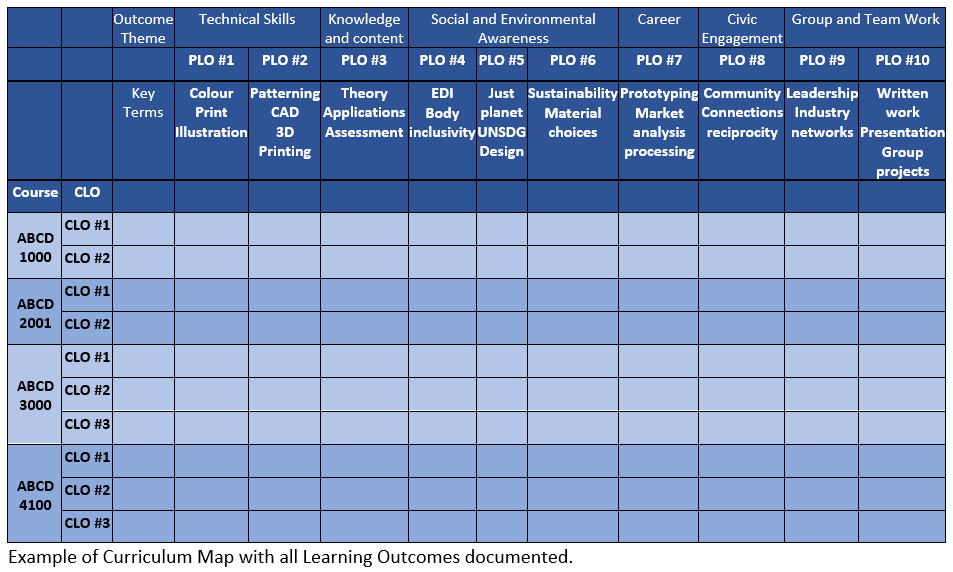
For a programs curriculum to be in alignment, the Course Learning Outcomes must support the Program Learning Outcomes. A very basic way of measuring this alignment is to measure the intersection between Course Learning Outcome and Program Learning Outcome. To do this, the Curriculum Team will review the first Course Learning Outcome for the first course and assess it against the first Program Learning Outcome. If the Curriculum Team feels that the Course Learning Outcome supports the Program Learning Outcome, they will mark the intersection of these outcomes with an X. If the team feels the Course Learning Outcome does not support the Program Learning Outcome, then the cell at the intersection of these two outcomes will remain blank. With the intersections assessed and marked or not, the Curriculum Team will move to the next Program Learning Outcome and assess whether the first Course Learning Outcome for the first course supports that Program Learning Outcome. This process continues until the first Course Learning Outcome for course #1 has been assessed against all the Program Learning Outcomes. The curriculum team then moves to the next Course Learning Outcome and continues to this process. This assessment and marking of intersections continue until every Course Learning Outcome has been assessed against every Program Learning Outcome. The Curriculum Team may then tally the count of intersections for each Program Learning Outcome below the Curriculum Map for a quantitative value of support for Program Learning Outcomes. While these sums are helpful for the Curriculum Teams, they are not part of the formal Curriculum Map and the rows should be hidden or deleted in the final document.
There is no correct number of intersections for a program. Highly prescriptive or regulated programs will have more intersections than more flexible programs. The Curriculum Team may identify any outliers that depart significantly from the average. If a departure is justified by the Curriculum Team, the rational should be noted in the Context Document. If there is no rational for a departure, the Curriculum Team may provide a recommendation for addressing this in the context document. If an outlier is particularly egregious the Curriculum Team may choose to rework a Program Learning Outcome. Once concerns are documented or resolved, the Curriculum Team may proceed.
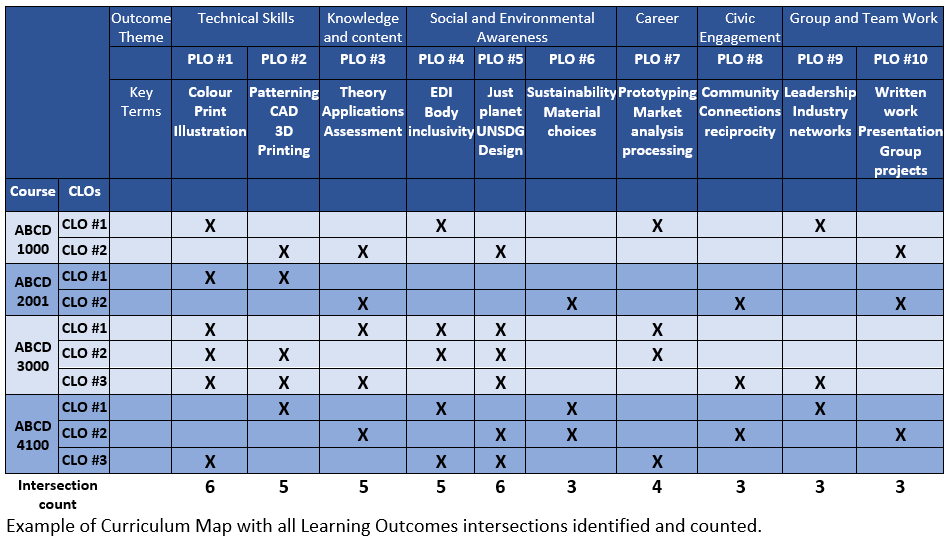
Once all the intersections have been marked, the Curriculum Team may choose to review the intersections and to note whether the Course Learning Outcome explicitly or implicitly supports the Program Learning Outcome. This is valuable as explicit support is seen to be stronger than implicit support. Categorizing the intersections in this way provides us with a value to assess the quality of Program Learning Outcome support as well as the quantity. If the Curriculum Team chooses to proceed with this assessment, they will review each “X” marking an intersection between the Course Learning Outcome and Program Learning Outcome and determine whether this is implicit or explicit support. If the support is implicit the “X” must be changed to an “M” (for i[M]plicit) and if the support is explicit the “X” (for e[X]plicit) remains. Once all intersections have been reassessed and updated to an “X” or an “M”, the Curriculum Team may tally the counts of implicit intersections and explicit intersections. With the count completed, the quality of the support may be identified by providing each Program Learning Outcome with one point for each “M” (implicit) intersection, two points for each “X” (explicit) intersection. Once the points are given and a sum is derived, each PLO will have a numerical value representing a Qualitative value of support for Program Learning Outcomes.

Some Curriculum Teams may choose to derive sums for explicit and implicit intersections for Course Learning Outcomes as well as Program Learning Outcomes. This can be very helpful for providing a closer look into how well lesson structures support course structures. This can also act as a confounding point as Lessons and Courses are the area most Subject Matter Experts are most familiar with, and they can tend to “Swirl” in this discussion focusing on the minutia rather than making meaningful decisions. It is important to remember that the support of the Program Learning Outcomes is the critical component of any Curriculum Map and must be promoted in priority. This is why the example above does not include the intersection count for Course Learning Outcomes. While these sums are helpful for the Curriculum Teams, they are not part of the Formal Curriculum Map and the rows should be hidden or deleted in the final document. Again, the Curriculum Team may identify any outliers that depart significantly from the average. If a departure is justified by the Curriculum Team, the rational should be noted in the Context Document. If there is no rational for this departure, the Curriculum Team may provide a recommendation for addressing this in the context document. If an outlier is particularly egregious the Curriculum Team may choose to rework a Program Learning Outcome. Once concerns are documented or resolved, the Curriculum Team may proceed.
With the intersections identified the Curriculum Team is in a position to begin evaluating the intersections. In this stage the Curriculum Team works to identify how the Course Learning Outcome supports the Program Learning Outcome. To do this the Curriculum Team will employ the IDA evaluation framework. This framework will require the Curriculum Team to review each intersection and determine if the Course Learning Outcome at a particular intersection is (I)ntroducing, (D)eveloping the ideas around, or (A)dvancing the concept of the Program Learning Outcome.
To create a comprehensive and complete curriculum map, it is recommended for the Curriculum Team to add an additional column under each Program Learning Outcome to record the assessment of each identified intersection. The Curriculum Team may use the “COUNTIF” function in Excel to track the occurrences of “I”s, “D”s and “A”s for each Program Learning Outcome.
With the “I”s, “D”s, and “A”s documented the Curriculum Team may begin reviewing the Curriculum Map for Gaps, Redundancies, or Misalignments. As a reminder gaps occur when Intersections at particular complexity level are under represented. As an example, a Program Learning Outcome with “D”s and “A”s but no “I”s. Redundancies are when intersections are overrepresented for example a Program Learning Outcome that is supported by every Course Learning Outcome is likely written too broadly and needs revision. Finally, Misalignments refer to problems with progression, for example, “D”s appearing before “I”s or “A”s appearing before “D”s.
If Gaps, Redundancies, or Misalignments are identified the Curriculum Team must review them and determine if there is a rationale for their occurrence. If there is a rationale for the occurrence, that is, it makes academic sense according to the Subject Matter Experts for the Gap, Redundancy or Misalignment to exist, then this rationale should be documented in the Context Document. If no rationale exists for the Gap, Redundancy, or Misalignment then the Curriculum Team may seek to resolve the concern or document its occurrence with a recommendation for the future in the Context Document. Once concerns are documented or resolved, the Curriculum Team may proceed to the next step.

While these sums are helpful for the Curriculum Teams, they are not part of the Formal Curriculum Map and the rows should be hidden or deleted in the final document.
Some Curriculum Teams may have chosen not to explore the implicit or explicit support of the curriculum, or maybe uninterested in creating a comprehensive curriculum map. Some Curriculum Teams may seek to develop a basic map for specific reporting purposes or as a preliminary assessment of if they need to go through the full process. In these cases, the recommendation is for the Curriculum Team to proceed without adding an additional column under the Program Learning Outcomes; rather replace the intersection indicators with the I, D, or A from the Evaluation framework. To do this the Curriculum Team will review each intersection of Program Learning Outcome and Course Learning Outcome denoted by an “X”, and replace this “X” with an I, D, or an A as appropriate to denote the level of complexity the intersection represents. From here the Curriculum Team is able to assess the curriculum for Gaps, Redundancies, and Misalignments as described above. This will provide a very basic perspective on the alignment of the curriculum and an end to the Curriculum Mapping Process.

COMPLETE MAPPING
With the Curriculum Map seen as accurate, or at least accurate enough to continue, the Curriculum Team may review the complexity of the intersection as denoted by the Evaluation framework and determine other factors involved in Constructive Alignment. This involves identifying the assessments and learning activities relevant to the Learning Outcome application required by the intersection of outcomes.
Every learning outcome is structured as a piece of knowledge, a skill or an attitude (KSA), to be demonstrated or assessed, and the conditions and criteria of that assessment. From this, it is clear that the creation of a learning outcome requires, at least, the consideration of an assessment of that outcome. So closely do assessments and outcomes resemble each other, that assessments are often included in course outlines as Course Learning Outcomes. Assessments are constructed alongside outcomes, closely resemble outcomes, and are components of curricular alignment. Assessments included in the Curriculum Map identify and track Program Learning Outcomes support and curricular alignment. Selecting the correct assessment can be challenging.
Course Learning Outcomes may support several Program Learning Outcomes. For example, an individual Course Learning Outcome may support four separate Program Learning Outcomes that speak to demonstrated:
- Theoretical Knowledge,
- Practical Applications,
- Industry Leadership, and
- Team or Group Work
With such diversity in the Program Learning Outcomes, there can be some confusion around how the Course Learning Outcome conducts its support. To demonstrate the curricular intention, and support future Curriculum users, it is important for the Curriculum Team to clearly demonstrate how the Course Learning Outcome supports each relevant Program Learning Outcome by identifying the associated assessments.
Looking at the above example, our Course Learning Outcome may cover all four Program Learning Outcomes at the same time. In this example the Course Learning Outcome may speak to the to the explicit demonstration of practical application, industry leadership and group work, while speaking to theoretical knowledge implicitly. In this case as assessment might be:
“In groups, prepare a report for a real-world facility. Identify the concern you’re seeking to address, why it’s important and how your recommendation will make an impact.”

The learner may, as part of a team, create a report to recommend recreational and therapeutic activities, based on factual results from other placements, for a retirement home looking to increase or maintain the cognitive acuity of their clients as measured by a Situational Judgement Test (SJT). Here, the learner is implicitly demonstrating their ability with theoretical knowledge of gerontology and theories of cognitive acuity. Their selection of placements and programs with real-world results, selection of and work with a real-world facility and work as part of a group explicitly demonstrates their abilities with practical applications, industry and group work. In this case, this one assessment may be used for all four Program Learning Outcomes that intersect with the one Course Learning Outcome. This is a fairly complex example expected to be at an advancing level of study.
At a more Introductory level with the same 4 Program Learning Outcomes:
- Theoretical Knowledge,
- Practical Applications,
- Industry Leadership, and
- Team or Group Work
The Curriculum Team may recommend that these are assessed separately. These separate assessments could look like:
- A quiz on Theories of Gerontology.
- The learner refers to a portrayal of a person in media and describes which of Erikson’s Stages of Development best fit.
- Interview with a representative from a Retirement Facility
- A team or group project
In this case, the assessment for each Program Learning Outcome will be different as different assessments are used for each intersection of the learning outcomes. Assessments may be for all Program Learning Outcomes intersected, one Learning Outcome or any number between.

With assessments recorded on the Curriculum Map, the Curriculum Team can recommend and document Instructional Activities to support students in performing well on these assessments on the Curriculum Map as well. Given the complexity of most Curriculum Maps and space limitations, it is recommended to record the full text of the Learning Outcomes on the Curriculum Map. The full wording for the Assessments and Instructional Activities may be recorded on the Course Outlines, with relevant keywords for the Assessment and Instructional Activities in additional columns under each Program Learning Outcome. With this information recorded, the Curriculum Map guides the Instructional Activities that help students perform well on the Assessments, and that demonstrate the Course Learning Outcome. This allows for clarity around curricular alignment, constructive alignment, and helps track assessment progression throughout an entire program.
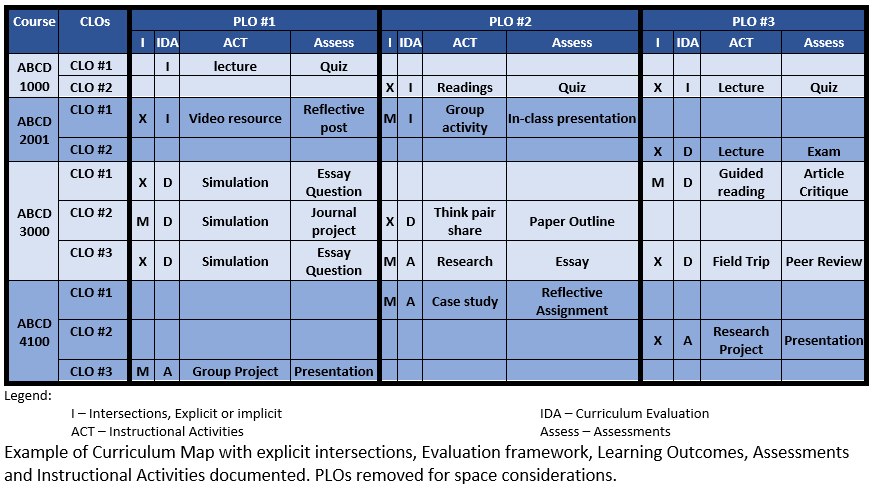
This can feel quite prescriptive to the Curriculum Team and future curriculum users. This level of mapping is not intended as a restriction, but as a guide for the Curriculum Teams intentions and suggestions to consider. A Curriculum Map at this level of comprehension provides guidance without limits around flexible programs and structure regarding program quality for highly regulated programs.
Mapping all components of Constructive Alignment has many benefits, and it does come with some challenges. Key among them is the effort required on the part of the Curriculum Team to document the Course Learning Outcome development, associated Assessments and relevant Instructional Activities on the Course Outlines, and then on the Curriculum Map. Curriculum Teams working to develop a completely new curriculum will need to develop all of this information. Another challenge is when Curriculum Teams are working to review an existing program rather than creating a new program. In many cases these Curriculum Teams will be left working with:
- Missing or Incomplete Materials
- Structure Learning Outcomes Differently
- Do Not have Learning Outcomes
- Base Assessment on Institutional Need (percentages) Rather than Student Need (performance)
- Are Highly Flexible
Information that is deficient or missing means the current Curriculum Team must create information to guide future Curriculum Users without having insight into to situation that resulted in the Curriculum they are working on. As always, it is best practice for the current Curriculum Team to discuss the missing information, make their decision and document this in the Context Document so it exists for future teams.
Now that the essential and key components of the Curriculum Map have been discussed recorded and documented, the Curriculum Team is in a position to begin assessing Content Milestones. As described earlier in this resource, Content Milestones are a method of identifying the content critical to learner progression through the program. All content is important and some parts of content must be learned in a particular order for the overall program to be effective.
These Content Milestones may have been evident to the Curriculum Team from the onset, or they have become clear through the discussions and the documentation involved in the mapping process. In any event, with the learning outcomes, assessments activities and levels of complexity clearly identified and documented in a visual matrix, the Curriculum Team is in an excellent position to define Program Content Milestones and then map their alignment and progression through the program on the Matrix Document.
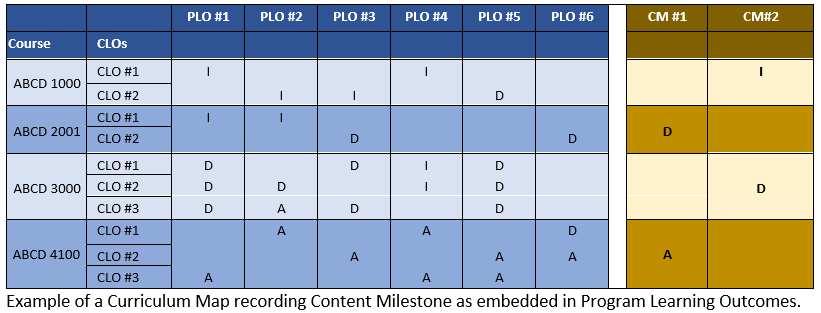
Once complete, the Curriculum Team will have a clear perspective on when in the program the milestones are being addressed, and with the documented Assessments, and Instructional Activities, clarity around how they are being addressed and how they are being assessed. The Assessment and Instructional information from the standard curriculum map will provide some additional information to the Content Milestone Map while separating their IDA Evaluation. This is important as some milestones may be introduced at a higher-level of study than others and relying on the Program Learning Outcomes only could skew the Milestone specific information. Again, this level of mapping is usually required only for highly structured or regulated programs, like some medical programs, and some trades.
For curriculum teams mapping a very flexible program, a much less detailed approach may be taken. For this less detailed approach, Content Milestones are listed in a cell under the relevant program learning outcome. The idea being that as the program learning outcome is developed so too is the content milestone. The Content Milestone is merely identified but its progress is tied to the progress of the program learning outcome. This row of Content Milestones is considered part of the formal Curriculum Map Matrix Document and is to be included in the map.
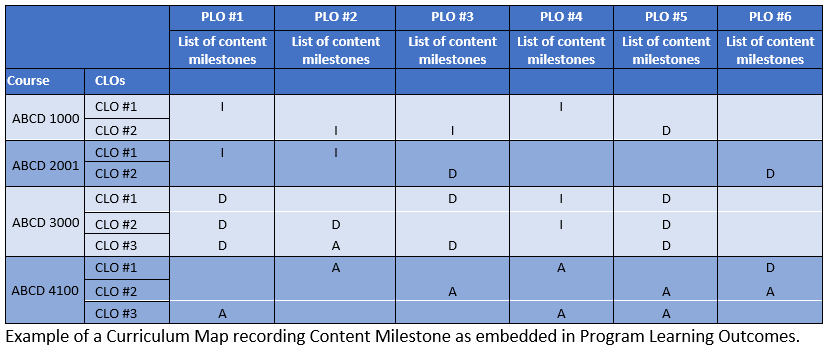
For Curriculum Teams looking for more information without the intensity of the first option, a third approach is possible. This hybrid approach we’ll see the Content Milestones listed underneath the relevant Program Learning Outcome as above. Where it differs is that the Curriculum Team will input the Content Milestone information into the relevant cell of an intersection between a Course Learning Outcome and the relevant Program Learning Outcome. The comment in this cell will identify the Content Milestone being supported. This will provide a visual indication of which Course Learning Outcomes intersecting with Program Learning Outcomes also support the development of Content Milestones.
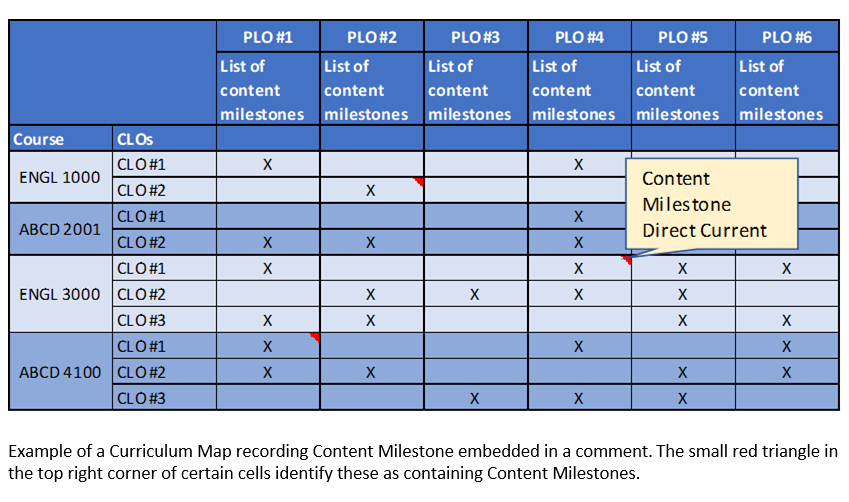
As with all the recommendations in this resource, should the Curriculum Team feel the curriculum information be better represented in a manner different from that recommended in this resource, they should proceed with their different approach. The Curriculum Team must record their information in the Curriculum Map Matrix Document and record the rationale for the departure from the recommendations presented in this resource in the Context Document.
This is the final step in mapping the program specific curriculum. Moving forward from here involves mapping required factors imposed on the curriculum.
As discussed earlier, many programs will have factors imposed on them by outside sources. These Imposed Factors may be directly related to, or completely removed from, the program content. Some of the examples previously given outlines more complex Imposed Factors such as shared core programs or foundational programs, and less complex Imposed Factors such as required credits or required quantitative/ analytical courses. It is important for the Curriculum Team to determine how these imposed factors may be best represented in the Curriculum Map. Some questions the Curriculum Team may consider when making this decision are:
- Could the factor be met implicitly?
- Must the factor be met explicitly?
- Measured for Present or not?
- Degree of required tracking of progression?
Once the Curriculum Team has identified how best to account for any Imposed Factors, they may Include them as a distinct component on the Curriculum Map. They must be adjacent and separate from either the Program Learning Outcomes, or the Course Learning Outcomes, and the rationale for their inclusion documented in the Context Document. With the imposed Factors documented in the Curriculum Map, the Curriculum Team is able to assess for intersections across the relevant axis. For factors that are measured solely for occurrence, there is no need to move beyond the intersection. For factors that require Progression Tracking, the Curriculum Team will implement the IDA Evaluation framework for that factor. Again, this must be recorded on the Curriculum Map Matrix Document and in the Context Document.
Examples:
1: Qualitative / Analytical and 6 Credits of English

2: Essential Skills

3: Core Program or Foundation
Imposed faculty or departmental outcomes may take several forms. The most frequent forms will include a shared selection of courses to be completed during the Educational Activity. A selection of courses that are intended to be completed early in the educational activity are often referred to as a Foundation program, while a selection of courses to be completed across the duration of the educational activity is referred to as a Core program. These Core or Foundation programs often represent a significant portion of the overall educational activity: five- ten courses of a 40-course credential. Occasionally when Core or Foundation programs are created they come with their own set of Program Learning Outcomes. Well-developed Core or Foundation programs will include a curriculum map detailing how the Learning Outcomes for the required courses will support the Core or Foundation’s Program Learning Outcomes. This is an important practice as it helps ensure these requirements, often significant portions of the Educational Activity, are well planned and in alignment with what they intend.
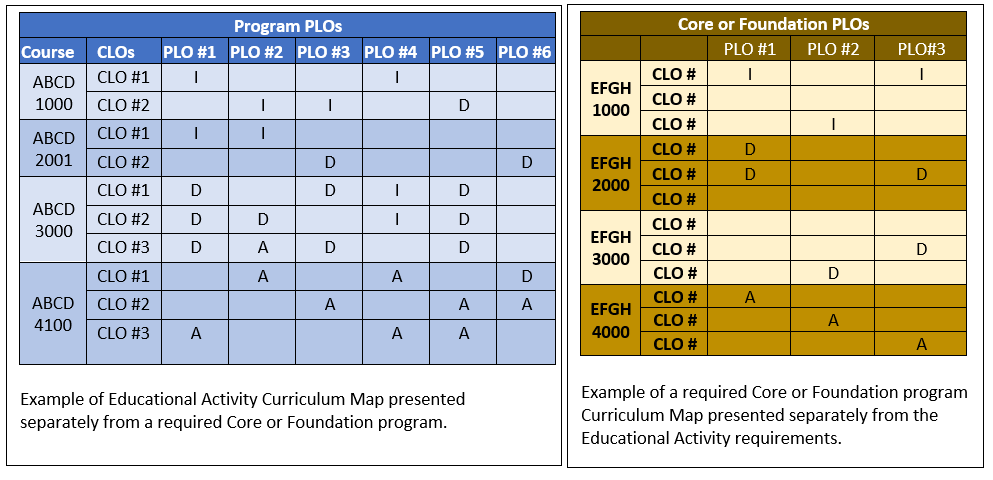
The challenge with this is the Course Learning Outcomes from Core or Foundation required courses are seldom assessed for their intersection with the Program Learning Outcomes for the rest of the Educational Activity. Additionally, the Course Learning Outcomes for the Educational Activity are seldom assessed for how well they support the Core or Foundation Program Learning Outcomes. As these programs tend to be 12 – 25 % of the total Educational Activity, this can be a significant blind spot in the Educational Activity.
To alleviate this possibility, it is the recommendation of this resource to first map the Course Learning Outcomes’ support of the Program Learning Outcomes for the Educational Activity (see quadrant 1 below).
Second, input the Program Learning Outcomes for the Core or Foundation program one column to the right on the same line as the Program Learning Outcomes for the Educational Activity (see quadrant 2 below)
Third, input the Course Learning Outcomes for the Core or Foundation program one row below in the same column as the Course Learning Outcomes for the Educational Activity (see quadrant 3 below) Finally, Plot the Curriculum Map for the Core or Foundation program in the intersection rows and columns (see quadrant 4 below).
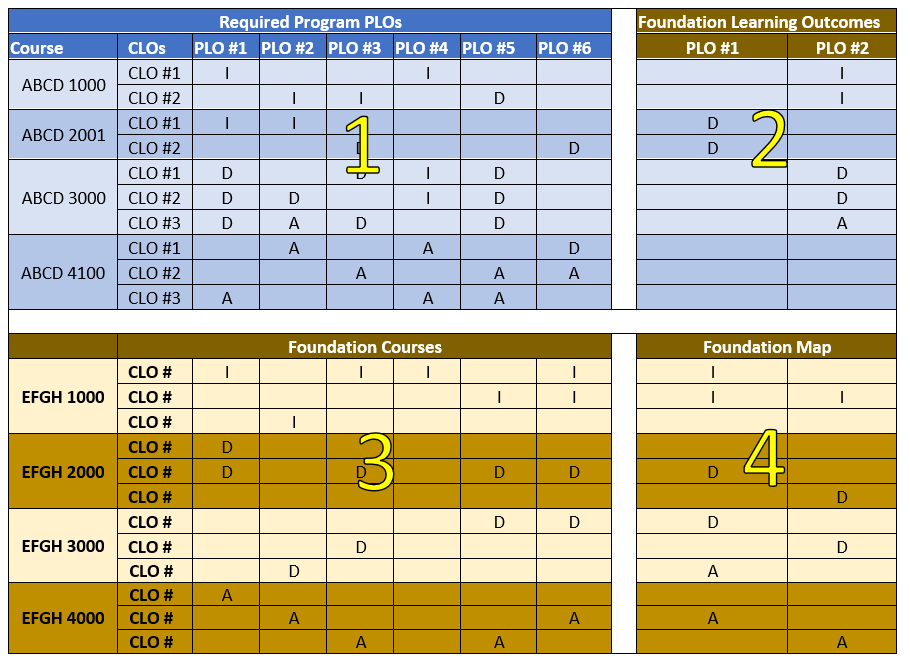
With this accomplished, the Curriculum Team is able to assess how the Core or Foundation Program Learning Outcomes are supported by the Educational Activity’s Course Learning Outcomes (quadrant 2) and assess how the Core or Foundation Course Learning Outcomes support the Educational Activity’s Program Learning Outcomes (quadrant 3).
This will provide a much more comprehensive perspective of the overall curriculum.
With all imposed Factors mapped, the Curriculum Team may review their Curriculum Map and determine if the Imposed Factors have been met or not. Imposed Factors that have not been met should be accommodated for in the curriculum, or a recommendation made that will guide students to a successful completion. The curriculum team will document all Imposed Factors, and recommendations in the Context Document.
PROCESS SUMMARY
There are many stages involved in the development of a Curriculum Map. Many of these stages will be fulfilled in a unique manner depending on the identified need and goals of the Curriculum Team. It is critical to the Process for the Curriculum Team to have a shared understanding of what is needed and why, before beginning the Process. Once the Process is complete, the Curriculum Team will be left with:
- An Exploration of Factors Document, providing insight into the intended, unintended and student experience curriculum, all the factors and the different curricular sites and answers to the questions posed by the Curricular inquiry.
- A Curriculum Map Matrix Document providing a simple visual representation of a very complex program that may include or be linked to course outlines and other supporting documentation
- A Context document outlining choices and rationale reflected in the Curriculum Map while providing clarity around what issues remain and guidance around considerations and how to achieve them
These documents will simplify the complexity of a curriculum, illustrating the key components so most viewers may understand the intended outcomes and means to achieve them. This will allow the full curriculum to be assessed for quality and allow this information to be communicated transparently and consistently for all involved in the curriculum, from planners to quality assurance professionals, to curriculum implementers, to learners, and learner supporters and their required use.